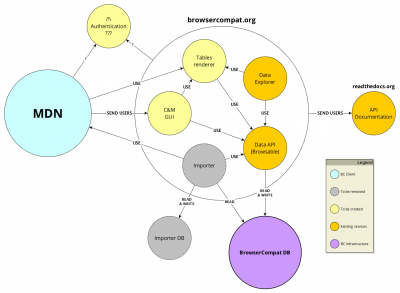MDN/Development/CompatibilityTables/Infrastructure
Here's a schema for the browsercompat.org services:
The BrowserCompat (bc) components are:
- MDN - primary consumer of compatibility data
- Data API - primary data data source
- BrowserCompat DB - stores current compatibility data
- Data Explorer - to browse compatibility data
- Importer - Scrapes data from MDN and injects into Data API
- Importer DB - stores extra import data
- C&M GUI - Contribution and moderation interface
- Tables renderer - for MDN and other services
- Authentication - end-user authentication services
- API documentation - describes data schema, other parts
Development
A local development copy of MDN is not required for BC development. MDN is backed by the mozilla/kuma project. Development is done using a local VM that provides many of the production services. See the installation documentation for details.
The Data API is in the mdn/browsercompat project. It is a Django project. Developers will need to install a Python development environment, and optionally will need PostgreSQL, Memcached, and Redis installed. See the Installation documentation for details.
The BrowserCompat DB can be a PostgreSQL database (recommended) or a SQLite database. It requires the Data API to setup the schema and populate the data. Compatibility data is periodically exported to the mdn/browsercompat-data project, and can be used to populate a developer's database.
The Data Explorer is part of the mdn/browsercompat project code base, and requires a local install of the Data API for development.
The Importer is part of the mdn/browsercompat project code base, and requires a local install of the Data API for development.
The Importer DB is currently part of the BrowserCompat DB. Local development may require a lengthy scraping of the MDN site.
The C&M interface is backed by the mdn/browsercompat-cm project. It is running Ember.js, with the ember-cli project. Developers will need to install the dependencies, including Node.js, Bower, ember-cli, and PhantomJS. See the README.md for details.
The Tables Renderer is still in planning, and the project has not started. A prototype renderer is implemented in KumaScript, in the EmbedCompatTable macro.
Local accounts are used for Authentication. For development, it is easiest to create local Django accounts backed by username and password. ``./manage.py createsuperuser`` can be used to create a superuser account with access to the Django admin.
The API documentation is hosted at browsercompat.readthedoc.org, and sourced in the mdn/browsercompat project. Documentation developers will need to install the Data API to build documents locally, but won't need to populate it with compatibility data.
Current Testing and Deployment Process
MDN is a mature product, with many layers of testing:
- Developers can run unit tests against their own code (``./manage.py test``)
- Pull Requests are tested in TravisCI
- Each pull request is reviewed by another developer using GitHub's PR interface.
- When accepted, PRs are merged to the master branch.
- The master branch is periodically deployed by a developer to staging at https://developer.allizom.org. Deployment is controlled by a script in the repository, and usually does not include manual steps.
- Developers and staff perform targeted manual testing of new features on staging.
- Intern is used to run client-side tests against the staging server.
- When testing is complete, the code is deployed to production. Developers monitor the site for 1 hour after production pushes, to be aware of any performance degradation.
A single codebase is used for the Data API, Data Explorer, Importer, and API Documentation. This project includes testing:
- Developers can run ``make test`` to run Django unit tests, and ``make qa`` to run code linters and coverage tests as well.
- Developers can run ``make test-integration`` to run a local API instance, load it with sample data, and make API requests.
- Pull requests are tested in TravisCI. This runs unit, QA, and integration tests.
- Some pull requests are code reviewed by other developers, because 1) the API does not include personally identifiable information, 2) the service is not in production use outside of some beta testers, and 3) no other developers are currently familiar with the code.
- When ready, PRs are merged to the master branch
- When the master branch is updated, the documentation is rebuilt and deployed to https://browsercompat.readthedocs.org
- The master branch is tested in TravisCI again.
- When testing is successful, the code is automatically deployed to https://browsercompat.herokuapp.com
Heroku hosts the BrowserCompat DB and the Importer DB in a single RDS PostgreSQL database. When the data schema changes, database migrations are run using the command-line heroku client (``heroku run --app browsercompat ./manage.py migrate``)
The C&M GUI is in early development. Developers can run tests with ``ember test``, but 100% success is not yet expected. No tests are automatically run on push.
Authentication is done against https://browsercompat.herokuapp.com, and is not specifically tested. Firefox Accounts was integrated, but has since broken.
The KumaScript-based table renderer is manually tested, and requires manually refreshing MDN pages when data changes. Stephanie Hobson has a test page linking to interesting pages.
